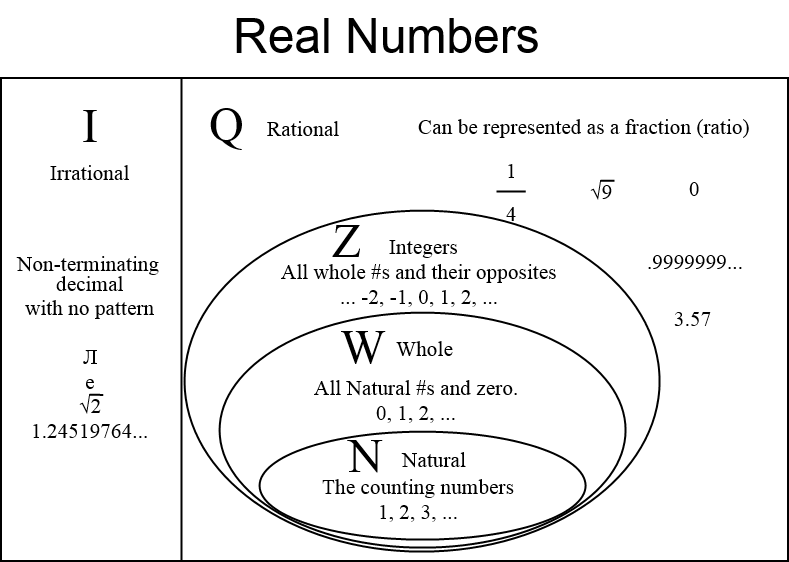Sets
Definition: A set is an onordered collection of items with something in common
Set vocabulary
Element - an item contained within a set
Order - The number of items in a set
Subset - A set where all the elements are also contained in another set
Null set - A set not containing any elements
Universal set - All possible values for the element, which are relevant.
Disjoint sets - No element between either set is shared.
Set notation
| Notation |
Meaning |
|
The element x is contained in the set A |
| |
The element x is not contained in the set A |
| |
The order of the set is x |
| |
Set A is a subset of set B |
|
The intersection between set A and B. Contains all shared elements between both sets. |
|
The union between set A and B. Contains all elements from both sets. |
|
A and B are disjoint sets. |
| |
A null set or empty set |
| or |
The universe |
Number Sets
There are different sytems in which we use to classify numbers and these are called the number sets.
| Number set |
Description |
Examples |
Symbol |
| Real numbers |
Any number which can be found on the number line. |
|
|
| Rational numbers |
Any number which can be expressed by a fraction of two integers. |
|
|
| Irrational numbers |
Any number which can't be expressed with a fraction. They have infinite non-repeating digts after the decimal place. |
|
|
| Integers |
Any numbers which can be expressed without decimals or fractions. |
|
|
| Whole numbers |
Positive integers including 0 |
|
|
| Natural numbers |
Positive integers excluding 0 |
|
|
| Negative integers |
All integers less than 0 |
|
|
Diagram

Exponents
An Exponent is the number that a number is raised to. This is also referred to as an indice.
Rules of exponents
Fractional exponents
A fractional exponent means that a number is being raised to the power of a fraction. It takes the form below:
Form:
Example:
Simplifying fractional exponents
We can easily simplify fractional indices by using the rules of indices.
Logarithims
A logarithm is simply an algorithm which take an input and a base and outputs the exponent needed to raise the base by to produce the input.
How to make a logarithm
A logarithm can be written using the form shown below:
n - the base
a - the input
b - the output
For example:
Logarithm rules
| Name |
Rule |
| Product rule |
|
| Quotient rule |
|
| Power rule |
|
| Change of base rule |
|
| Equality rule |
|
View count: 10776